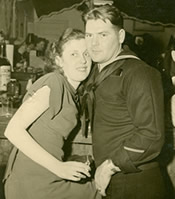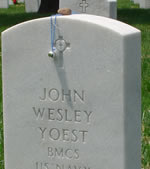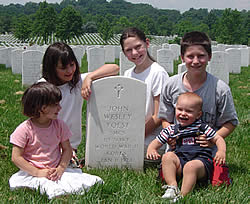Memorial Day: 2009
The Penta-Posse at
Arlington National Cemetery, 2005 Charmaine wrote this a few years ago.
Every time we’ve made the left turn onto Eisenhower Drive, and passed through the imposing brick gates of Arlington National Cemetery, I’ve been overwhelmed with emotion. Family members of those buried at Arlington National Cemetery are given a special pass and may drive onto the Hallowed Grounds to visit the grave of their loved one. It’s an enormous honor which makes me feel humbled.
My husband’s father served thirty years in the United States Navy, and died the year I married into the family, so I didn’t know him well. And the fact is, after a lifetime of nine-month Mediterranean tours, wars, and rumors of war, there is a lot my husband doesn’t know as well.
However, over the 15 years that we’ve been married, I have gotten to know my mother-in-law well. She doesn’t talk either about the sacrifices she made, but there is one story that she has told me several times.
Once, when my father-in-law was out on tour, and she was home with three small children, the car broke down and, of course, she had to take care of it. My husband marched up and said, “Don’t worry, Mom, I’ll fix it.” He was about five years old at the time.
My mother-in-law laughs. . . the little man, takin’ care of things. But it makes me cry.
We owe a lot to our military families.
When we visited Arlington this past week, we passed at least three funeral ceremonies on the way to Section 64. I lost track of the fresh graves and the still-standing tents, either just vacated by other grieving families, or awaiting the afternoon’s fresh, raw sorrow.
As we pulled up on Bradley Avenue, an Air Force honor guard was marching precisely back to their bus after a ceremony for an airman who had been a POW in Korea. While we searched for my father-in-law’s headstone, an empty horse-drawn caisson lumbered past, and settled briefly in the shade nearby, awaiting their next assignment. . .

We found my father-in-law’s headstone: The front has the Christian Cross with the old Chief’s Curriculum Vita. Chief Yoest cut high school to catch World War II. He retired with rows of ribbons and a “v” device, and pinned butterbars on his boy. He now has a grandson, The Dude, who bears his name and wants to be a Navy pilot.
The reverse of the stone is blank, awaiting the inscripton for Chief Yoest’s high school sweetheart, his wife, Jack’s mom, “Babcia” (Polish for Grandmother), who is still with us. In the end, they will be buried together, an honor she earned.
As we turned to go, the Diva took her jingle-bell necklace from around her neck, and left it on the headstone. A fitting tribute for a warrior.

Sailors, rest your oars.
We drove back down Bradley Avenue — past a fresh grave covered by a tarp. In front of us, sparkling in the bright sunlight of a gorgeous day, stretched row after row of white marble markers, orderly, peaceful, some weathered, others new and crisply chiseled . . .
I turned to the Penta-Posse. “I want you to look,” I said. “I want you to understand, that each one of these headstones represents someone who gave their life so that you could be free.”
They were quiet and solemn. The weight of it is beyond measure.
The Dreamer said, “Don’t cry, Mom.”
We made the right turn onto Eisenhower. We drove slowly toward the exit, passing the drive to the Tomb of the Unknowns to our left, until we came to a crosswalk thronged with tourists. The guard on duty motioned to the crowd to stop, and we drove through, passing through the gates, back to a busy day, leaving behind — the curious crowds, the chattering school children. . . and the silent stones.
This weekend, we mark the 140th anniversary of the first official observation of the holiday we now call Memorial Day, as established by General John A. Logan’s “General Order No. 11” of the Grand Army of the Republic dated 5 May, 1868.
This order reads in part: “The 30th day of May 1868 is designated for the purpose of strewing with flowers and otherwise decorating the graves of comrades who died in defense of their country during the late rebellion, and whose bodies lie in almost every city, village and hamlet churchyard in the land.”
Logan’s order served to ratify a practice that was already widespread, both in the North and the South, in the years immediately following the Civil War.
Alas, for many Americans today, Memorial Day has come to signify nothing more than another three-day weekend, a mere excuse for a weekend cook-out.
Such an observance of Memorial Day obscures even the vestiges of its intended meaning: a solemn time, serving both as catharsis for those who fought and survived, and to ensure that those who follow will not forget the sacrifice of those who died that the American Republic and the principles that sustain it, might live.
“Mac” continues,
Lincoln’s Gettysburg Address gives universal meaning to the particular deaths that occurred on that hallowed ground, thus allowing us to understand Memorial Day in the light of the Fourth of July, to comprehend the honorable end of the soldiers in the light of the glorious beginning and purpose of the nation.
The deaths of the soldiers at Gettysburg, of those who died during the Civil War as a whole, and indeed of those who have fallen in all the wars of America, are validated by reference to the nation and its founding principles as articulated in the Declaration of Independence.
Some will object, claiming that linking Memorial Day and Independence Day glorifies war and trivializes individual loss and the end of youth and joy. How can the loved ones of a fallen soldier ever recover from such a loss?
I corresponded with the mother of one of my Marines who died in Vietnam for some time after his death. He was an only child and her inconsolable pain and grief put me in mind of Rudyard Kipling’s poem, Epitaphs of the War, verse IV, “An Only Son”:
I have slain none but my mother, She
(Blessing her slayer) died of grief for me.
Kipling too, lost his only son in World War I.
But as Holmes said in 1884, “[G]rief is not the end of all. I seem to hear the funeral march become a paean. I see beyond the forest the moving banners of a hidden column. Our dead brothers still live for us, and bid us think of life, not death — of life to which in their youth they lent the passion and joy of the spring.
As I listen, the great chorus of life and joy begins again, and amid the awful orchestra of seen and unseen powers and destinies of good and evil our trumpets sound once more a note of daring, hope and will.”
This Memorial Day the household of Your Business Blogger(R) will fly our Flag as we always do and remember those who “gave the last full measure” and died in service.
Nearby head stones tell of service men who died far too soon. Far too young. In war for us.
Danny Boy
The Ballad
The Irish classic Danny Boy has a long and varied history. The following explanation is my favorite and the simplest,
Once, a long time ago there was an old man who had raised many sons who he loved dearly. A war raged over the land that they lived in and one by one he saw each of them go off to fight and not return. Then one day, as harvest time drew near, he knew that his youngest, and most precious, son would soon be going off to fight just as his brothers before him. The old man was sad and knew that he may never see his last boy alive. He looked intently at the young lad, and with tears in his eyes he sang this song.
The ballad cannot begin to reveal the emotion and the pain of fathers and mothers who bury sons in a time of war.
I do not know how families do this.
But I do know that we must be grateful.
We are so lucky. Happy Memorial Day.
See Meditation on Suffering and Sacrifice,
The famous chapel on the grounds of the United States Air Force Academy nestled at the base of the Rocky Mountains is more truly a cathedral. Outwardly, it is all sleek silver-wing metal, with seventeen external buttresses, knifing severely skyward. Designed to evoke an air-frame, the architecture does not immediately summon spiritual devotion.
But cross the threshold, step inside, and one is transported to another plane. The solemn air is bathed in the soft splendor of muted light. While the stern steel silhouette dominates the external view, the interior reveals the fragile panels of stained-glass that the harsh ribs support. The intricate glass panes filter and animate the sunlight, illuminating the sacred space with almost a visual hush.
At the front of the chapel, a single row is roped off. “Reserved” the sign says, for all the United States aviators who are missing in action or prisoners of war. The only occupant of the pew is a single, burning candle.
“Greater love hath no man than this. . .” reads the plaque. The Scripture it alludes to concludes: “that a man lays down his life for his friends.”
My thoughts immediately fly to my boy, my sweet Dude, who wants to be a fighter pilot. And baby Boo, who will almost certainly want to follow his older brother. My heart blanches. How could I bear it? And yet so many other mothers — gold-star mothers — even this very day, must find a way when their sons have given the last measure of devotion.
Be sure to read Charmaine’s post from 2005, Memorial Day: Arlington National Cemetery
Danny Boy Lyrics at Memorial Day, 2008, Danny Boy.
Follow us on Twitter: @jackyoest @charmaineyoest


Recent Comments